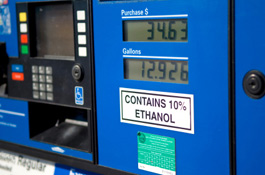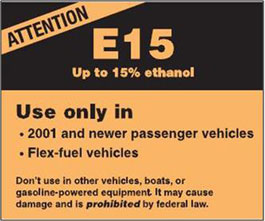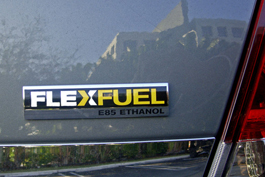Ethanol can be used as a transportation fuel
The most common use of fuel ethanol is in mixtures of finished motor gasoline. Most gasoline sold in the United States contains some ethanol. The exact amount may vary by region and season of the year. In general, the ethanol content of motor gasoline does not exceed 10% by volume.
E10, E15, and E85 are the three primary gasoline-fuel ethanol blends
In the United States, gasoline pumps that dispense motor gasoline containing fuel ethanol identify or label the gasoline according to the maximum level of the ethanol blend: E10, E15, and E85. A blend of 10% ethanol and 90% gasoline (by volume) is known as E10 gasoline. Motor gasoline with up to 15% ethanol content is called E15. E10 is the primary source of U.S. ethanol consumption.
E85 is a gasoline-ethanol blend containing 51% to 83% ethanol, depending on geography and season. E85 is defined as an alternative fuel. Although most E85 use in the United States occurs in the Midwest, about 4,300 public E85 fueling stations are located around the country.
All models of vehicles sold in the United States can use E10, but only light-duty vehicles with a model year 2001 or newer can use gasoline blends higher than E10 unless the vehicle is a flexible-fuel (flex-fuel) vehicle. Flex-fuel vehicles can run on any mixture of ethanol and gasoline up to E85. Flex-fuel vehicles may be identified by a badge or plaque on the body of the vehicle with E85, Flex Fuel, or FFV.
Because ethanol has about 67% of the energy content of gasoline per gallon, using ethanol blends results in lower vehicle fuel economy (miles traveled per gallon) than gasoline that does not contain ethanol. For example, vehicle fuel economy may decrease by about 3% when using E10.
Government policies help boost ethanol use
Ethanol was one of the first automotive fuels in the United States. Except during the two world wars, only small amounts of fuel ethanol were used until the 1970s. The oil embargo against the United States by major oil producers in the Middle East in 1973 and increases in oil prices in the late 1970s and early 1980s spurred interest in fuel ethanol as a way to reduce U.S. oil imports. Various state and federal government policies and programs dating as far back as the mid-1970s have led to increased ethanol use in gasoline. About two million gallons of fuel ethanol were consumed in 1981, and about 14 billion gallons were consumed in 2022. Fuel ethanol consumption dropped in 2020, along with gasoline consumption, because of the economic-related effects of the COVID pandemic. Fuel ethanol consumption increased in 2021 as the economy returned to normal activitiy.
In 2011, the U.S. Congress let a 45-cent-per-gallon tax credit for ethanol blenders and a 54-cent-per-gallon tariff on ethanol imports expire. This decision was largely due to a well-established U.S. ethanol industry amid rising concerns about the federal budget deficit. The tax credit for blenders had been available for three decades.
Renewable Fuel Standard Program requires fuel ethanol blending into gasoline
Fuel ethanol use increased significantly in 2002 as states began to ban the gasoline oxygenate known as methyl tertiary butyl ether (MTBE) because of concerns that it contaminated groundwater. Ethanol quickly replaced MTBE as a gasoline oxygenate across the country. Ethanol use also increased after Congress passed the Renewable Fuel Standard (RFS) requirements under the Energy Policy Act of 2005 and then expanded and extended the RFS under the Energy Independence and Security Act of 2007. The RFS requires U.S. renewable fuel use to increase annually until it reaches 36 billion gallons by 2022.
The U.S. Environmental Protection Agency (EPA) is responsible for developing and implementing the U.S. Renewable Fuel Standard (RFS) Program to ensure that transportation fuel sold in the United States contains a minimum volume of renewable fuel.
The RFS targets were based on the assumption that U.S. gasoline consumption will increase over time, so more ethanol can be blended with gasoline in the future. The saturation of the United States' gasoline supply with ethanol sold as E10, termed the blend wall, motivated the ethanol industry to seek approval to supply a midlevel ethanol blend—E15. The blend wall is the point at which fuel supply infrastructure and all vehicle engines would need to be updated to be compatible with blends greater than E10. The fuel ethanol percentage share of total motor gasoline consumption has been greater than 10% since 2017.
The EPA is developing processes and procedures on how ethanol blends greater than E10 can be sold. The EPA ruled in January 2011 that E15 can be used in cars and light trucks built after the 2001 model year. The EPA also approved a new E15 label for gasoline pumps so consumers know what fuel they are buying. Only flex-fuel vehicles can use higher blends, such as E85.
Last updated: February 23, 2024.



